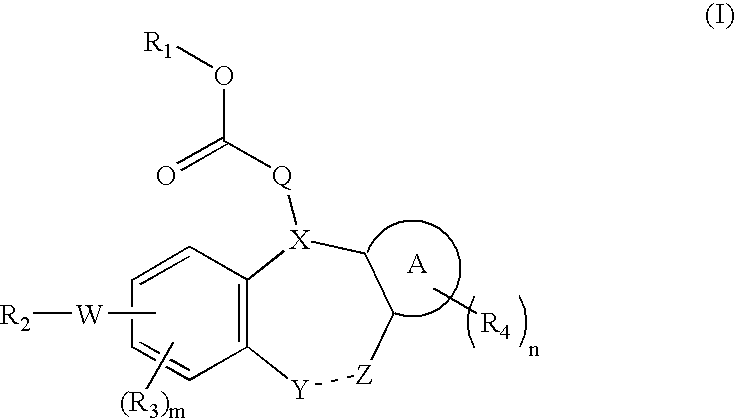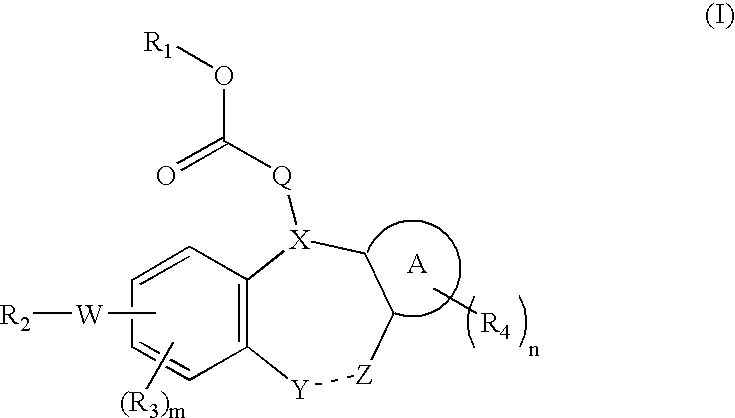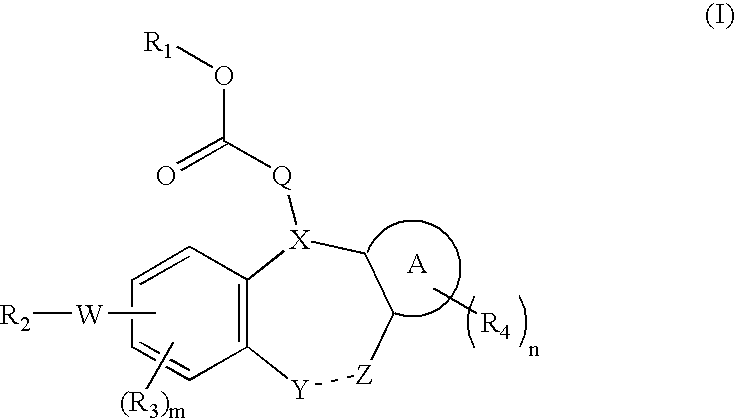Integrin receptor inhibitors
a technology of integrin receptor and inhibitor, which is applied in the field of compounds, can solve the problems of inherently cumbersome production
- Summary
- Abstract
- Description
- Claims
- Application Information
AI Technical Summary
Benefits of technology
Problems solved by technology
Method used
Image
Examples
example 1
Synthesis of Compound 5
[0080]
[0081]Commercially available 2-amino-9-fluorenone 1 (10 mmol) was dissolved in 100 mL of methanol and 0.38 g (10 mmol) of sodium borohydride was added. The mixture was stirred at 25° C. for 1 h and concentrated to dryness under vacuum. The residue was suspended in 100 mL of saturated aqueous NaHCO3− and extracted with ethylacetate (100 mL). The ethylacetate layer was concentrated under vacuum and the residue was crystallized from ethylacetate / hexane (2:1) to afford 1.4 g of pure 2-amino-9-hydroxyfluorene 2.
[0082]Compound 2 (0.39 g; 2 mmol) was dissolved in 50 mL of anhydrous DMF and cooled to 0° C. under nitrogen. Lithium bistrimethylsilylamide (2 mmol; 1M in THF) was added dropwise and stirring was continued for 30 min. Iodoethylacetate (3 mmol) was added dropwise and the solution was stirred 12 h at 0° C. The reaction mixture was poured into 200 mL of water and extracted with ethyl acetate (200 mL). The extract was concentrated and the product was puri...
example 2
Synthesis of 2-amino Carbazole
[0085]
[0086]Carbazole (100.24 g) was suspended in acetic anhydride (300 mL) with catalytic boron trifluoride etherate (0.65 mL) and the solution refluxed for 25 min. then cooled to 0° C. and the solid was then collected and recrystallized from hexane to give 82.65 g 9-acetyl-carbazole.
[0087]9-Acetyl-carbazole (41.85 g, 0.2 mol) was dissolved in 1 L methylene chloride and 28.5 mL acetylchloride (0.4 mol) and 120 g aluminum chloride (0.9 mol) were added and the solution refluxed for 1.5 h. The solution was cooled to −78° C. and 6N HCl was added slowly while stirring and allowed to warm to room temperature. Methylene chloride was added to dissolve the precipitate and the solution was extracted, and the organics dried over Na2SO4, decolorized with charcoal, filtered and concentrated. Recrystallization from benzene / hexane gave 27.9 g 2,9-diacetylcarbazole.
[0088]2,9-Diacetylcarbazole, (25.1 g, 0.1 mol) was dissolved in 100 mL pyridine. Hydroxylamine hydrochlo...
example 3
Synthesis of Compound 6
[0089]
[0090]To 0.1 g (0.55 mmol) 2-aminocarbazole in 6 mL DMF was added 0.37 g (1.65 mmol) of N-Ac-L-Tyr, 0.37 g (1.65 mmol) HBTU and 0.3 mL (1.7 mmol) DIPEA. The reaction was stirred for 1 h, poured into ethyl acetate and washed consecutively with 0.1N H2SO4, aq. NaHCO3 and brine then dried over Na2SO4 and concentrated. Flash chromatography (10% methanol / methylene chloride) gave 0.16 g (0.26 mmol) of the acetylated amine. This was stirred for 1 h with cesium carbonate (0.185 g, 0.57 mmol) and ethyl bromoacetate (0.043 mL, 0.39 mmol) in 4 mL DMF and then poured into ethyl acetate and washed with saturated NH4Cl and brine and dried over Na2SO4 and concentrated. Without purification this was dissolved in 5 mL THF and 5 mL water and 0.043 g (1 mmol) LiOH was added. The ester was cleaved in 2SO4, and brine and then dried over Na2SO4 and concentrated. The product was lyophilized and purified by HPLC.
PUM
| Property | Measurement | Unit |
|---|---|---|
| Length | aaaaa | aaaaa |
Abstract
Description
Claims
Application Information
 Login to View More
Login to View More - R&D
- Intellectual Property
- Life Sciences
- Materials
- Tech Scout
- Unparalleled Data Quality
- Higher Quality Content
- 60% Fewer Hallucinations
Browse by: Latest US Patents, China's latest patents, Technical Efficacy Thesaurus, Application Domain, Technology Topic, Popular Technical Reports.
© 2025 PatSnap. All rights reserved.Legal|Privacy policy|Modern Slavery Act Transparency Statement|Sitemap|About US| Contact US: help@patsnap.com



